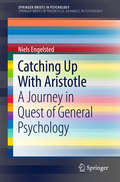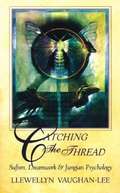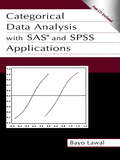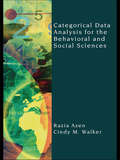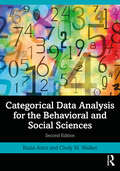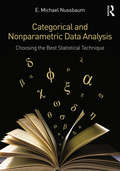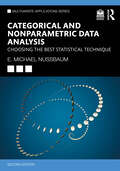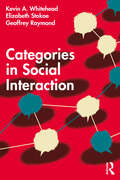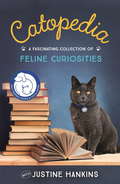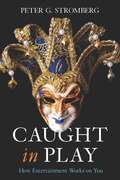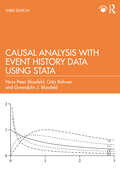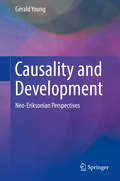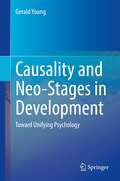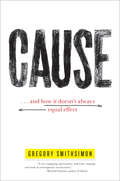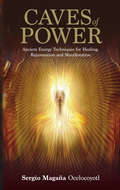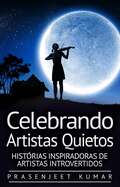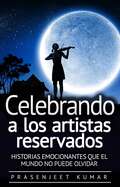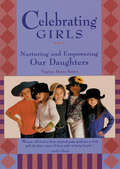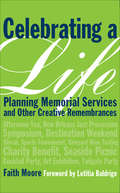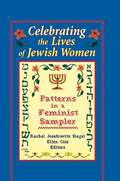- Table View
- List View
Catching Time: Temporality, Interaction, and Cognition (Literary Criticism and Cultural Theory)
by Isabelle Wentworth'Time travels in divers paces with divers people.' Shakespeare’s oft-quoted line contains a hidden ambiguity: not only do individual people experience time differently, but time travels in diverse paces when we are with diverse persons. The line articulates a contemporary understanding of subjective time: it is changed by interaction with our social environment. Interacting with other people—and even literary characters—can slow or quicken the experience of time. Interactive time, and the paradigm of enactive cognition in which it sits, calls for an expansion of traditional ideas of time in narrative. The first book-length study of interactive time in narrative, Catching Time explains how lived time and narrative time interpenetrate each other, so that the relational model of subjective time acts as a narrative function. Catching Time develops a novel, interdisciplinary framework, drawing on cognitive science, narratology, and linguistics, to understand the patterns of temporality that shape narrative.
Catching Up With Aristotle: A Journey in Quest of General Psychology (SpringerBriefs in Psychology)
by Niels EngelstedThis Brief presents the argument for the need to re-establish the theoretical focus of general psychology in contemporary psychological research. It begins with a detailed account of the current "crisis" of psychology and our modern disconnect from general psychology. Chapters present the works of Aristotle and A. N. Leontiev, using their ideas to outline a long wanted general psychology. The general psychology delineates the four corner posts of the domain of psychology: Sentience, Intentionality, Mind, and Human Consciousness, and explains why they are all necessary but not the same. Besides a historical discussion, which aims to demonstrate how Marxism got it right, and then not, this Brief presents a new radical theory of human evolution, which credits the Adam-and-Eve story with a vital link hitherto missed by Marxism, Darwinism, and paleoanthropology. In addition, it argues why a new understanding is important in the Anthropocene Age. Catching Up with Aristotle will be of interest to psychologists, undergraduate and graduate students, and researchers.
Catching the Thread - Sufism, Dreamwork, and Jungian Psychology
by Llewellyn Vaughan-LeeSpiritual life is a process of inner transformation in which the whole psychic structure of the seeker is changed. Exploring the threshold between spirituality and psychology, Llewellyn VaughanLee shows how dreamwork guides us on this inner journey and helps us to understand the different stages of the path. From the transformative darkness of the shadow he takes us into the love affair with our inner partner, and from there into the archetypal realm and the symbolic dimension of the Self...
Categorical Data Analysis With Sas and Spss Applications
by Bayo Lawal H. Bayo LawalThis book covers the fundamental aspects of categorical data analysis with an emphasis on how to implement the models used in the book using SAS and SPSS. This is accomplished through the frequent use of examples, with relevant codes and instructions, that are closely related to the problems in the text. Concepts are explained in detail so that students can reproduce similar results on their own. Beginning with chapter two, exercises at the end of each chapter further strengthen students' understanding of the concepts by requiring them to apply some of the ideas expressed in the text in a more advanced capacity. Most of these exercises require intensive use of PC-based statistical software. Numerous tables with results of analyses, including interpretations of the results, further strengthen students' understanding of the material. Categorical Data Analysis With SAS(R) and SPSS Applications features: *detailed programs and outputs of all examples illustrated in the book using SAS(R) 8.02 and SPSS on the book's CD; *detailed coverage of topics often ignored in other books, such as one-way classification (ch. 3), the analysis of doubly classified data (ch. 11), and generalized estimating equations (ch. 12); and *coverage of SAS(R) PROC FREQ, GENMOD, LOGISTIC, PROBIT, and CATMOD, as well as SPSS PROC CROSSTABS, GENLOG, LOGLINEAR, PROBIT, LOGISTIC, NUMREG, and PLUM. This book is ideal for upper-level undergraduate or graduate-level courses on categorical data analysis taught in departments of biostatistics, statistics, epidemiology, psychology, sociology, political science, and education. A prerequisite of one year of calculus and statistics is recommended. The book has been class tested by graduate students in the department of biometry and epidemiology at the Medical University of South Carolina.
Categorical Data Analysis for the Behavioral and Social Sciences
by Razia Azen Cindy M. WalkerFeaturing a practical approach with numerous examples, this book focuses on helping the reader develop a conceptual, rather than technical, understanding of categorical methods, making it a much more accessible text than others on the market. The authors cover common categorical analyses and emphasize specific research questions that can be addressed by each analytic procedure so that readers are able to address the research questions they wish to answer. To achieve this goal, the authors: Review the theoretical implications and assumptions underlying each of the procedures Present each concept in general terms and illustrate each with a practical example Demonstrate the analyses using SPSS and SAS and show the interpretation of the results provided by these programs. A "Look Ahead" section at the beginning of each chapter provides an overview of the material covered so that the reader knows what to expect. This is followed by one or more research questions that can be addressed using the procedure(s) covered in the chapter. A theoretical presentation of the material is provided and illustrated using realistic examples from the behavioral and social sciences. To further enhance accessibility, the new procedures introduced in the book are explicitly related to analytic procedures covered in earlier statistics courses, such as ANOVA and linear regression. Throughout each chapter the authors use practical examples to demonstrate how to obtain and interpret statistical output in both SPSS and SAS. Their emphasis on the relationship between the initial research question, the use of the software to carry out the analysis, and the interpretation of the output as it relates to the initial research question, allows readers to easily apply the material to their own research. The data sets for executing chapter examples using SAS Version 9.1.3 and/or IBM SPSS Version 18 are available on a book specific web site. These data sets and syntax allow readers to quickly run the programs and obtain the appropriate output. The book also includes both conceptual and analytic end-of-chapter exercises to assist instructors and students in evaluating the understanding of the material covered in each chapter. This book covers the most commonly used categorical data analysis procedures. It is written for those without an extensive mathematical background, and is ideal for graduate courses in categorical data analysis or cross-classified data analysis taught in departments of psychology, human development & family studies, sociology, education, and business. Researchers in these disciplines interested in applying these procedures to their own research will appreciate this book’s accessible approach.
Categorical Data Analysis for the Behavioral and Social Sciences
by Razia Azen Cindy M. WalkerFeaturing a practical approach with numerous examples, the second edition of Categorical Data Analysis for the Behavioral and Social Sciences focuses on helping the reader develop a conceptual understanding of categorical methods, making it a much more accessible text than others on the market. The authors cover common categorical analysis methods and emphasize specific research questions that can be addressed by each analytic procedure, including how to obtain results using SPSS, SAS, and R, so that readers are able to address the research questions they wish to answer. Each chapter begins with a "Look Ahead" section to highlight key content. This is followed by an in-depth focus and explanation of the relationship between the initial research question, the use of software to perform the analyses, and how to interpret the output substantively. Included at the end of each chapter are a range of software examples and questions to test knowledge. New to the second edition: The addition of R syntax for all analyses and an update of SPSS and SAS syntax. The addition of a new chapter on GLMMs. Clarification of concepts and ideas that graduate students found confusing, including revised problems at the end of the chapters. Written for those without an extensive mathematical background, this book is ideal for a graduate course in categorical data analysis taught in departments of psychology, educational psychology, human development and family studies, sociology, public health, and business. Researchers in these disciplines interested in applying these procedures will also appreciate this book’s accessible approach.
Categorical and Nonparametric Data Analysis: Choosing the Best Statistical Technique (Multivariate Applications Series)
by E. Michael NussbaumFeaturing in-depth coverage of categorical and nonparametric statistics, this book provides a conceptual framework for choosing the most appropriate type of test in various research scenarios. Class tested at the University of Nevada, the book's clear explanations of the underlying assumptions, computer simulations, and Exploring the Concept boxes help reduce reader anxiety. Problems inspired by actual studies provide meaningful illustrations of the techniques. The underlying assumptions of each test and the factors that impact validity and statistical power are reviewed so readers can explain their assumptions and how tests work in future publications. Numerous examples from psychology, education, and other social sciences demonstrate varied applications of the material. Basic statistics and probability are reviewed for those who need a refresher. Mathematical derivations are placed in optional appendices for those interested in this detailed coverage. Highlights include the following: Unique coverage of categorical and nonparametric statistics better prepares readers to select the best technique for their particular research project; however, some chapters can be omitted entirely if preferred. Step-by-step examples of each test help readers see how the material is applied in a variety of disciplines. Although the book can be used with any program, examples of how to use the tests in SPSS and Excel foster conceptual understanding. Exploring the Concept boxes integrated throughout prompt students to review key material and draw links between the concepts to deepen understanding. Problems in each chapter help readers test their understanding of the material. Emphasis on selecting tests that maximize power helps readers avoid "marginally" significant results. Website (www.routledge.com/9781138787827) features datasets for the book's examples and problems, and for the instructor, PowerPoint slides, sample syllabi, answers to the even-numbered problems, and Excel data sets for lecture purposes. Intended for individual or combined graduate or advanced undergraduate courses in categorical and nonparametric data analysis, cross-classified data analysis, advanced statistics and/or quantitative techniques taught in psychology, education, human development, sociology, political science, and other social and life sciences, the book also appeals to researchers in these disciplines. The nonparametric chapters can be deleted if preferred. Prerequisites include knowledge of t tests and ANOVA.
Categorical and Nonparametric Data Analysis: Choosing the Best Statistical Technique (Multivariate Applications Series)
by E. Michael NussbaumNow in its second edition, this book provides a focused, comprehensive overview of both categorical and nonparametric statistics, offering a conceptual framework for choosing the most appropriate test in various scenarios. The book’s clear explanations and Exploring the Concept boxes help reduce reader anxiety. Problems inspired by actual studies provide meaningful illustrations of these techniques. Basic statistics and probability are reviewed for those needing a refresher with mathematical derivations placed in optional appendices.Highlights include the following:• Three chapters co-authored with Edgar Brunner address modern nonparametric techniques, along with accompanying R code.• Unique coverage of both categorical and nonparametric statistics better prepares readers to select the best technique for particular research projects.• Designed to be used with most statistical packages, clear examples of how to use the tests in SPSS, R, and Excel foster conceptual understanding.• Exploring the Concept boxes integrated throughout prompt students to draw links between the concepts to deepen understanding.• Fully developed Instructor and Student Resources featuring datasets for the book's problems and a guide to R, and for the instructor PowerPoints, author's syllabus, and answers to even-numbered problems.Intended for graduate or advanced undergraduate courses in categorical and nonparametric statistics taught in psychology, education, human development, sociology, political science, and other social and life sciences.
Categories We Live By: How We Classify Everyone and Everything
by Gregory L. MurphyAn in-depth analysis of how humanity&’s compulsion to categorize affects every aspect of our lived experience.The minute we are born—sometimes even before—we are categorized. From there, classifications dog our every step: to school, work, the doctor&’s office, and even the grave. Despite the vast diversity and individuality in every life, we seek patterns, organization, and control. In Categories We Live By, Gregory L. Murphy considers the categories we create to manage life&’s sprawling diversity. Analyzing everything from bureaucracy&’s innumerable categorizations to the minutiae of language, this book reveals how these categories are imposed on us and how that imposition affects our everyday lives.Categories We Live By explores categorization in two parts. In part one, Murphy introduces the groundwork of categories—how they are created by experts, imperfectly captured by language, and employed by rules. Part two provides a number of case studies. Ranging from trivial categories such as parking regulations and peanut butter to critical issues such as race and mortality, Murphy demonstrates how this need to classify pervades everything. Finally, this comprehensive analysis demonstrates ways that we can cope with categorical disagreements and make categories more useful to our society.
Categories in Social Interaction
by Kevin A. Whitehead Elizabeth Stokoe Geoffrey RaymondThis book investigates the situated (re)production of categories, from the most mundane and unremarkable to those most strongly associated with power and privilege. By examining the reciprocal relationships between categorial phenomena and the basic structures and practices of social interaction, the book provides a new framework for integrating conversation analysis and membership categorization analysis.Across its ten chapters, the book describes a conversation analytic approach to studying categories and categorization, charts the development and history of membership categorization analysis, and addresses core methodological challenges and practices associated with using this approach. After mapping out the new framework developed in the book, each chapter describes intersections between categorial phenomena and the domains that comprise the infrastructure of social interaction. The book concludes by exploring applications, interventions, and impacts of understanding categories in ways examined across the preceding chapters, and by considering future avenues for excavating categorial practices in the ordinary, institutional, and technological settings of human social life.Categories in Social Interaction is essential reading for social scientists with an interest in categories of people and categorizing practices, and especially for practitioners and students of conversation analysis, membership categorization, ethnomethodology, and discursive psychology.
Category Specificity in Brain and Mind (Brain, Behaviour and Cognition)
by Glyn W. Humphreys Emer M.E. FordeSome of the most fascinating deficits in neuropsychology concern the failure to recognise common objects from one semantic category, such as living things, when there is no such difficulty with objects from another, such as non-living things. Over the past twenty years, numerous cases of these 'category specific' recognition and naming problems have been documented and several competing theories have been developed to account for the patients' disorders.Category Specificity in Brain and Mind draws together the neuropsychological literature on category-specific impairments, with research on how children develop knowledge about different categories, functional brain imaging work and computational models of object recognition and semantic memory. The chapters are written by internationally leading psychologists and neuroscientists and the result is a review of the most up-to-date thinking on how knowledge about different categories is acquired and organized in the mind, and where it is represented in the human brain. The text will be essential reading for advanced undergraduates and researchers in the field of category specificity and a rich source of information for neuropsychologists, experimental and developmental psychologists, cognitive scientists and philosophers.
Catopedia: A fascinating collection of feline curiosities
by Justine Hankins Battersea Dogs HomeWhy do cats cry to come in and then cry to go out again? Why do they chatter silently at the window? Why can't they be trained to fetch your slippers? Where are the most unusual places they've been employed as mousers? Why are there so many cat superstitions? This cat compendium educates and entertains with facts about everything from wild cat ancestry and cat physiology to cat worship and cat movie stars. We'll investigate how cats experience the world and what they think of their human companions and explore why cats have inspired both reverence and fear throughout history. Drawing on the vast body of knowledge belonging to the world's most famous dogs and cats home, the book contains numerous snippets that readers can dip into as well as longer essays and stories that can be enjoyed at leisure. Attractively designed, with charming illustrations, and beautifully packaged as a hardback gift book, this is the ideal present for every cat lover.
Caught in Play
by Peter G. StrombergStromberg (anthropology, U. of Tulsa) explores the effects of entertainment on values of pleasure, self-indulgence and consumption and notes the ease in which fans succumb to media ideas and practices. Written for students and scholars, this book explains the links between romantic realism and consumer culture and examines the writings of noted social theorists to reveal how entertainment has replaced rituals in modern societies. The author also describes the methods employed by the entertainment industry to satisfy "stimulus hunger. " Annotation ©2009 Book News, Inc. , Portland, OR (booknews. com)
Causal Analysis with Event History Data Using Stata
by Hans-Peter Blossfeld Götz Rohwer Gwendolin J. BlossfeldThis third edition of Causal Analysis with Event History Data Using Stata provides an updated introduction to event history modeling along with many instructive Stata examples. Using the latest Stata software, each of these practical examples develops a research question, points to useful contextual background information, gives a brief account of the underlying statistical concepts, describes the organization of input data and the application of Stata statistical procedures, and assists the reader in interpreting the content of the results obtained. Emphasizing the strengths and limitations of continuous-time event history analysis in different fields of social science applications, this book demonstrates that event history models provide a useful approach to uncover causal relation- ships or to map a system of causal relationships. In particular, this book demonstrates how long-term processes can be studied, how different forms of duration dependencies can be estimated using nonparametric, parametric and semiparametric models, and how parallel and interdependent dynamic systems can be analyzed from a causal-analytical point of view using the method of episode splitting. The book also shows how changing contextual information at the micro, meso and macro levels can be easily integrated into a dynamic analysis of longitudinal data. Finally, the book addresses the problem of unobserved heterogeneity of time-constant and time-dependent omitted variables and makes suggestions for dealing with these sometimes difficult methodological problems.Causal Analysis with Event History Data Using Stata is an invaluable resource for both novice and experienced researchers from a variety of fields (e.g. sociology, economics, political science, education, psychology, demography, epidemiology, management research and organizational studies, as well as medicine and clinical applications) who need an introductory textbook on continuous-time event history analysis and who are looking for a practical handbook for their longitudinal research.
Causality and Development: Neo-Eriksonian Perspectives
by Gerald YoungThe third book in Young’s unique trilogy on causality and development continues to locate and define the central role of causality in biopsychosocial and network/systems development, and as a unifying concept of psychology itself. As a way of discussing causality, in general, initially, the book focuses on the acquisition of handedness and hemispheric specialization in infancy and childhood, and their relations to the development of cognition, language, and emotion, in particular. The second part of the book elaborates an innovative 25-step Neo-Eriksonian model of development across the life course based on a Neo-Piagetian model covered in the previous books, completing a step-by-step account of development over the lifespan cognitively and socio-emotionally. It builds on the concept of neo-stage, which is network-based. From this conceptual synthesis, the author’s robust theory of development and causality identifies potential areas for psychological problems and pathology at each developmental step as well as science-based possibilities for their treatment. This elegant volume:Presents a clear picture of the development of handedness and laterality in more depth than has been attempted in the literature to date.Traces the causal concepts of activation-inhibition coordination and networking in the context of development.Describes in depth a novel 25-step Neo-Eriksonian lifespan model of development.Reviews relevant research on Piagetian and Eriksonian theories in development.Emphasizes the clinical utility of the described 25-step Neo-Eriksonian approach to lifespan development. A significant step in understanding this highly nuanced subject and synthesizing a broad knowledge base, Causality and Development will find an interested audience among developmental psychologists, mental health practitioners, academics, and researchers.chers.
Causality and Neo-Stages in Development: Toward Unifying Psychology
by Gerald YoungThis book represents a broad integration of several major themes in psychology toward its unification. Unifying psychology is an ongoing project that has no end-point, but the present work suggests several major axes toward that end, including causality and activation-inhibition coordination. On the development side of the model building, the author has constructed an integrated lifespan stage model of development across the Piagetian cognitive and the Eriksonian socioaffective domains. The model is based on the concept of neo-stages, which mitigates standard criticisms of developmental stage models. The new work in the second half of the book extends the primary work in the first half both in terms of causality and development. Also, the area of couple work is examined from the stage perspective. Finally, new concepts related to the main themes are represented, including on the science formula, executive function, stress dysregulation disorder, inner peace, and ethics, all toward showing the rich potential of the present modeling.
Cause: . . . And How It Doesn't Always Equal Effect
by Gregory SmithsimonThe Freakonomics of the sociology world. This book shows how deeply irrational we humans are, and what we can do about itWhen we try to understand our world, we ask “why?” a specific event occured. But this profoundly human question often leads us astray. In Cause, sociologist Gregory Smithsimon brings us a much sharper understanding of cause and effect, and shows how we can use it to approach some of our most daunting collective problems.Smithsimon begins by explaining the misguided cause and effect explanations that have given us tragically little insight on issues such as racial discrimination, climate change, and the cycle of poverty. He then shows unseen causes behind these issues, and shows how we are hard-wired to overlook them. Armed with these insights, Smithsimon explains how we can avoid these mistakes, and begin to make effective change.Combining philosophy, the science of perception, and deeply researched social factors, Cause offers us a new way to ask “why?” and a hope that we may improve our society and ourselves.
Caves of Power: Ancient Energy Techniques for Healing, Rejuvenation and Manifestation
by Sergio MaganaMany people across the world today are looking for their true selves. The ancient Mexicans viewed this true self as the ‘caves’, which referred to our spirit, instincts, and subconscious. According to the Mexican tradition, we have seven caves of power, which are equivalent to the chakras, and healing these caves allows us to improve all areas of our lives. InThe Caves of Power, world-renowned Mexican healer Sergio Magaña unveils this almost lost and secret knowledge of the ancient Mexicans. He shares powerful practices for healing, rejuvenation, manifestation, and enlightenment, which include: Mexican numerology, astral surgery, dream work, Mexican acupuncture, energy spinning, and Mexican Kundalini techniques. This unique and powerful book brings a new approach to an ancient tradition to bring healing and resolution to our most important issues: health, emotions, abundance, and enlightenment.
Cedar House: A Model Child Abuse Treatment Program
by Bobbi Kendig Clara LowryThis inspiring book describes the treatment approach, the clientele, and the community networking of Cedar House, a pioneering and successful child abuse treatment program in Long Beach, California. Cedar House: A Model Child Abuse Treatment Program explains Cedar House’s hands-on treatment of families in which children have been abused. Each facet of the treatment process is explored and explained. The authors offer ideas on how the treatment they used can be adapted to your own treatment setting. Cedar House: A Model Child Abuse Treatment Program gives practitioners hope, ideas, and support for hands-on work with multiproblem individuals and families, along with some pitfalls to avoid. Those treating clients who attempt to intimidate with bullying behavior or outbursts can gain understanding and more confidence to deal with others’anger. In addition, therapists and administrators will find ideas for the prevention of burnout. The theme of the book springs from a mind-set of inclusiveness--including clients in every step of the process related to them, enlisting their abilities to help each other as well as themselves, embracing community members in the search for answers, and providing channels for people at all levels to give and to grow. You’ll gain new perspective on treatment efforts as Cedar House: A Model Child Abuse Treatment Program explores: nine premises on which the Cedar House program is based the use of staff volunteers as a team actual client profiles and case studies elements of the treatment approach at Cedar House findings from two student research projects relating to the children of Cedar House Cedar House’s relationship with the community a contemporary evaluation of Cedar House and follow-up comments from former clients regarding their families 15--20 years after treatment findings from a study of the dynamics of rage to better understand the breeding ground of violence and abuseCedar House: A Model Child Abuse Treatment Program dispels stereotypes and stresses the rewards of child abuse treatment and the joy found in sharing the journey as families find their footing and as children grow and develop. In 1979, Cedar House became the model treatment center for Los Angeles County’s Neighborhood Family Centers.
Celebrando Artistas Quietos: Histórias Inspiradoras de Artistas Introvertidos
by Prasenjeet Kumar Makoto YamamotoFinalmente, um livro que elogia a criatividade e a rica imaginação dos introvertidos ** Do Autor de Vários Best-Sellers ** Você acha mesmo que lendas como Steven Spielberg, Agatha Christie, J.K. Rowling, Leonardo Da Vinci, Amitabh Bachchan e outros eram extrovertidos e descontraídos – ao contrário de você? Não. Absolutamente errado. Eles eram quietos e introvertidos. Como eu e você. Mesmo assim, a contribuição deles é bem conhecida. Imaginem um mundo SEM eles. Como seria? Sem Harry Potter. Sem Mona Lisa. Sem Hercule Poirot. Sem o Inspetor Vijay. Sem E.T. Então, se esses artistas eram realmente introvertidos como você e eu, como deixaram uma marca tão indelével neste mundo? Eles aprenderam a ser falsos extrovertidos? A se socializar? A falar sem parar? De jeito nenhum. Eles permaneceram fiéis a si mesmos. Ficou confuso? Então compre este livro agora mesmo! E curta a intrigante biografia desses artistas que usaram as abençoadas vantagens da introversão para superar tragédias, desafios e obstáculos.
Celebrando a los artistas reservados: Historias emocionantes que el mundo no puede olvidar
by Prasenjeet Kumar Marcela Vilas MartínezPor fin un libro que celebra la creatividad y rica imaginación de los artistas introvertidos ** De un autor nº1 en ventas ** ¿De verdad crees que leyendas como Steven Spielberg, Agatha Christie, J.K. Rowling, Leonardo Da Vinci, Amitabh Bachchan y similares eran extrovertidos y abiertos, no como tú? No. Totalmente equivocado. Eran tranquilos. E introvertidos. Como yo. Como tú. Y aun así, su contribución es muy conocida. Tan sólo imagina un mundo SIN ellos. ¿Cómo sería? Sin Harry Potter. Sin Mona Lisa. Sin Hercule Poirot. Sin Inspector Vijay. Sin E.T. Así que si esos artistas eran introvertidos, como tú y como yo, ¿cómo dejaron tan indelible impronta en este mundo? ¿Aprendieron a ser falsos extrovertidos? ¿Practicaron habilidades sociales? ¿Aprendieron a hablar sin parar? Cielos, no. Permanecieron fieles a sí mismos. ¿Intrigado? ¡Entonces adquiere hoy un ejemplar! Y disfruta de muchas historias refrescantes de artistas introvertidos que usaron sus fortalezas divinas de introversión para sobrellevar tragedias que rompen el corazón, retos y contratiempos.
Celebrating Girls: Nurturing and Empowering Our Daughters
by Virginia Beane RutterA mother&’s guide to supporting a girls&’ self-worth as she grows: &“Inspired.&”—Isabel Allende In this book, Jungian psychologist Virginia Beane Rutter offers a wide variety of everyday things women can do to strengthen a girl&’s sense of self and ensure confidence and healthy self-esteem throughout her lifetime. Whether rooted in traditions of many cultures, new and creative, or connected to the daily tasks of everyday life, they offer practical ways to support daughters, and celebrate the passage from infancy to adolescence. &“Adeptly suggests ways mothers can use traditionally feminine pastimes—shopping, storytelling, even brushing or braiding a child&’s hair—to instill in a daughter a strong sense of self.&”—Pubishers Weekly
Celebrating The Other: A Dialogic Account Of Human Nature
by Edward E. SampsonT he title, Celebrating the Other, is based on Clark and Holquist's (1984) reference to Mikhail Bakhtin's dialogic theory as a celebration of alterity. Like Bakhtin's work, mine is designed to provide a long overdue celebration of the other. For too long our major cultural and scientific views have been monologic and self celebratory - focusing more on the leading protagonist and the supporting cast that he has assembled for his performances than on others as viable people in their own right. Time now to celebrate the other - not only to set the record of our understanding straight but, of equal importance, to give voice, and in their own register and form, to those who have been condemned to silence.
Celebrating a Life: Planning Memorial Services and Other Creative Remembrances
by Faith MooreA guide of alternatives to traditional funerals, commemorating lost loved ones in a meaningful, personal way. Today, many people are forgoing the trappings and timeworn rituals of typical funerals, and are instead opting to celebrate their loved ones&’ lives. With careful planning, services like these can truly honor the person who has died—and both comfort and uplift those who attend. Celebrating a Life offers sensitive guidance on every detail—venue, food and drink, music, flowers, eulogy, program, mementoes—all with the aim of making sure the memorial service&’s honoree is remembered just as he or she would have wished. Checklists and an extensive resource directory provide much-needed help to those who have very little time to make arrangements. As author Faith Moore says, this book is not about regrets, but about reimagining how we say good-bye. &“In a caring, practical, and authoritative way, Faith Moore tackles a very difficult topic. Her direct and warm advice is a fabulous resource. This book is a must-read for anyone who will face the inevitability of honoring and celebrating the life of a deceased love one.&” —Peggy Post, director of the Emily Post Institute and author of Emily Post&’s Etiquette, 17th Edition
Celebrating the Lives of Jewish Women: Patterns in a Feminist Sampler
by Ellen Cole Esther D Rothblum Rachel J SiegelJewish women of all ages and backgrounds come together in Celebrating the Lives of Jewish Women to explore and rejoice in what they have in common--their heritage. They reveal in striking personal stories how their Jewishness has shaped their identities and informed their experiences in innumerable, meaningful ways. Survivors, witnesses, defenders, innovators, and healers, these women question, celebrate, and transmit Jewish and feminist values in hopes that they might bridge the differences among Jewish women. They invite both Jewish and non-Jewish readers to share in their discussions and stories that convey and celebrate the multiplicity of Jewish backgrounds, attitudes, and issues.In Celebrating the Lives of Jewish Women, you will read about cultural, religious, and gender choices, conversion to Judaism, family patterns, Jewish immigrant experiences, the complexities of Jewish secular identities, antisemitism, sexism, and domestic violence in the Jewish community. As the pages unfold in this wonderful book of personal odysseys, the colorful patterns of Jewish women’s lives are laid before you. You will find much cause for rejoicing, as the authors weave together their compelling and unique stories about: midlife Bat mitzvah preparations the transmission of Jewish values by Sephardi and Ashkenazi grandmothers traditional Sephardi customs the sorrow and healing involved in coping with the Holocaust a lesbian’s fascination with Kafka the external and internal obstacles Jewish women encounter in their efforts to study Jewish topics and participate in Jewish ritual becoming a Reconstructionist rabbi the difficulties and benefits of being the teenaged daughter of a rabbiA harmonious chorus of individual voices, Celebrating the Lives of Jewish Women will delight and inspire Jewish and non-Jewish readers alike. It reminds each of us how diverse and distinctive Jewish women’s lives are, as well as how united they can be under the wonderful fold of Judaism. This book will be of great interest to all women, as well as to rabbis, Jewish community leaders and professionals, mental health workers, and those in Jewish studies, women’s studies, and multicultural studies.

